
by Thomas Derbes II | Aug 23, 2024
Oysters are not only powerful filterers, they also provide a home and habitat for many marine organisms. Most of these organisms will fall off while the oysters are being harvested or cleaned, but some will stay behind and can be found inside or outside of your oyster on the half shell. Seeing some of these creatures might give you the “heebie jeebies” about eating the oyster, they are perfectly safe and can either be removed or, in some cases, consumed for luck. These creatures include mud worms (Polydora websteri), “pea crabs” (Pinnotheres ostreum or Zaops ostreus), and “mud crabs” (Panopeus herbstii, Hexapanopeus angustifrons or Rhithropanopeus harrisii).
Mud Worms (Polydora websteri)
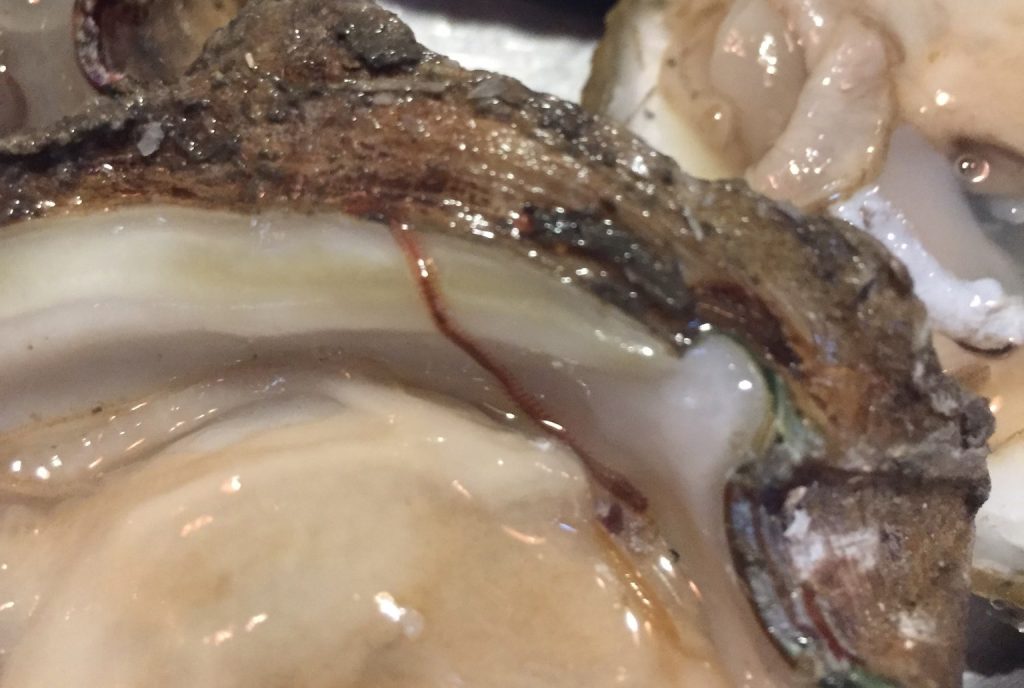
A Mud Worm in an Oyster – Louisiana Sea Grant
One of the more common marine organisms you can find on an oyster is the oyster mud worm. These worms are typically red in color and form a symbiotic relationship with the oyster. Mud worms can be found in both farmed and wild harvest oysters throughout the United States. These worms will typically form a “mud blister” and emerge when the oyster has been harvested. Even though the worms look menacing and unsightly, they are a sign of a fresh harvest and a good environment. Mud worms do not pose any threat to humans and can be consumed.
If you find a mud worm on your next oyster and are still unsure, just simply remove the worm and dispose of it. Dr. John Supan, retired professor and past director of Louisiana Sea Grant’s Oyster Research Laboratory on Grand Isle, mentioned in an article that oyster mud worms “are absolutely harmless and naturally occurring,” and “if a consumer is offended by it while eating raw oysters, just wipe it off and ask your waiter/waitress for another napkin. Better yet, if there are children at the table, ask for a clear glass of water to drop the worm in. They are beautiful swimmers and can be quite entertaining.”
“Pea Crabs” (Pinnotheres ostreum or Zaops ostreus)
“Pea Crabs” are in fact two different species of crabs lumped together under one name. Pea crabs include the actual pea crab (Pinnotheres ostreum) and the oyster crab (Zaops ostreus). These crabs are so closely associated with oysters that their species name contains some form of the Latin word “ostreum” meaning oyster! Pea crabs are known as kleptoparasites and will embed themselves into the gills of an oyster and steal food from the host oyster. Even though they steal food, they seem to pose no threat to the oyster and are a sign of a healthy marine ecosystem.

A Cute Little Pea Crab – (C)2013 T. Michael Williams
Pea crabs are soft-bodied and round, giving them the pea name. Pea crabs can be found throughout the Atlantic coast, but are more concentrated in coastal areas from Georgia to Virginia. While they might look like an alien from another planet, they are considered a delicacy and are typically consumed along with the oyster. If you are brave enough to slurp down a pea crab, you might just be rewarded with a little luck. According to White Stone Oysters, “historians and foodies alike agree that finding a pea crab isn’t just a small treat, it’s also a sign of good luck!”
“Mud Crabs” (Panopeus herbstii, Hexapanopeus angustifrons or Rhithropanopeus harrisii)
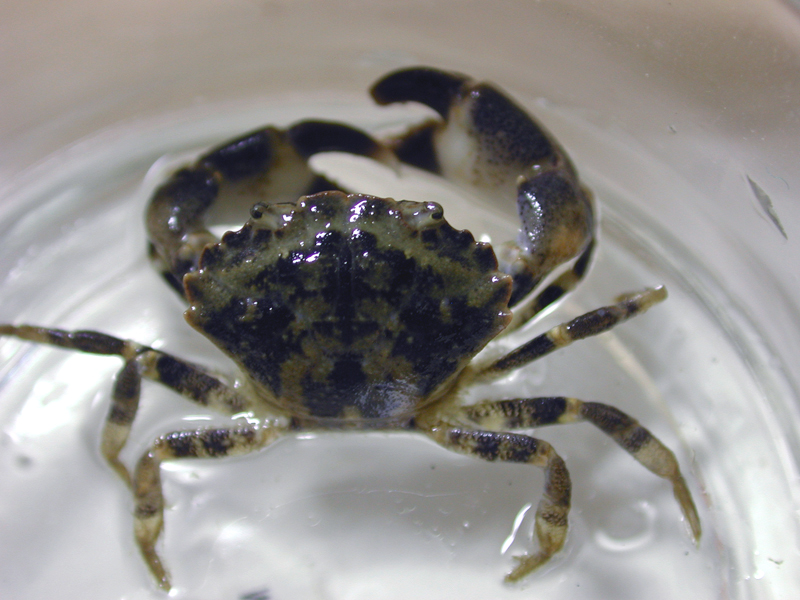
Smooth Mud Crab – Florida Shellfish Lab
Just like pea crabs, “mud crabs” is another name for two different species of crabs commonly found in oysters. These crabs, the Harris Mud Crab (Rhithropanopeus harrisii), Smooth Mud Crab (Hexapanopeus angustifrons), and the Atlantic mud crab (Panopeus herbstii) to name just a few, reach a maximum size of 2 to 8 centimeters and are hard-bodied, unlike the pea crabs. Mud crabs can survive a wide range of salinities, but need cover to survive as these crabs are common prey for most of the oyster habitat dwellers, such as catfish (Ariopsis felis), redfish (Sciaenops ocellatus), and sheepshead (Archosargus probatocephalus). These crabs are not beneficial to an oyster environment as they will seek out young oysters and consume them by breaking the shell with their strong claws. If you find a mud crab in your oyster, this is one to dispose of before consuming. However, these crabs typically live on the outside of an oyster and are typically only found when you buy a sack of oysters and do not have an effect on the quality of the oyster.
Don’t Be Afraid
Hopefully this article has helped shed some light on the creatures you might experience when shucking or consuming oysters. Here is a helpful online tool to help identify some marine organisms associated with clam and oyster farms (Click Here). While most of the organisms can be consumed, we recommend the mud crabs be disposed of due to their hard shells. Remember, some of these organisms can bring you luck and with college football season around the corner, some of us might need all the luck we can get! Bring on the pea crabs!
References Hyperlinked Above
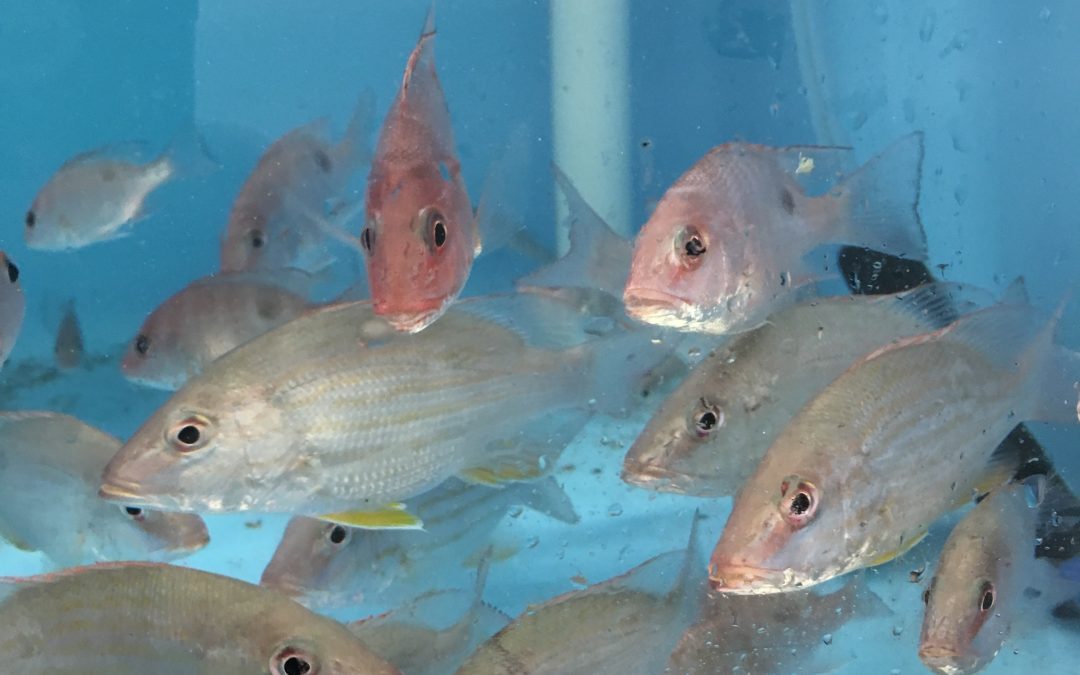
by Thomas Derbes II | Aug 10, 2024
Many of us are given that Birds and the Bees talk; another majority have had to give it as an adult to their kids. It is usually an awkward talk, but someone had to step up to the plate and put on a straight face. I am happy to be the one today to discuss one section of the Birds and the Bees of the Sea, batch spawning. Batch spawning, also known as broadcast spawning, is the coordinated release of gametes (sperm and eggs) into the water column. Batch spawning is not just relegated to fish, many species of invertebrates also batch spawn. Some of the most commonly encountered batch spawners include Florida Pompano (Trachinotus carolinus), Eastern Oyster (Crassostrea virginica), Red Drum (Sciaenops ocellatus), Red Snapper (Lutjanus campechanus), and Gag Grouper (Mycteroperca microlepis), to name a few. In fact, most gamefish species in the Gulf of Mexico are batch spawners. This has its advantages, but also has its major disadvantages. We will dive headfirst into a few representative species of saltwater organisms that batch spawn, and their respective life stages to help shed some light on reproduction in the marine world.
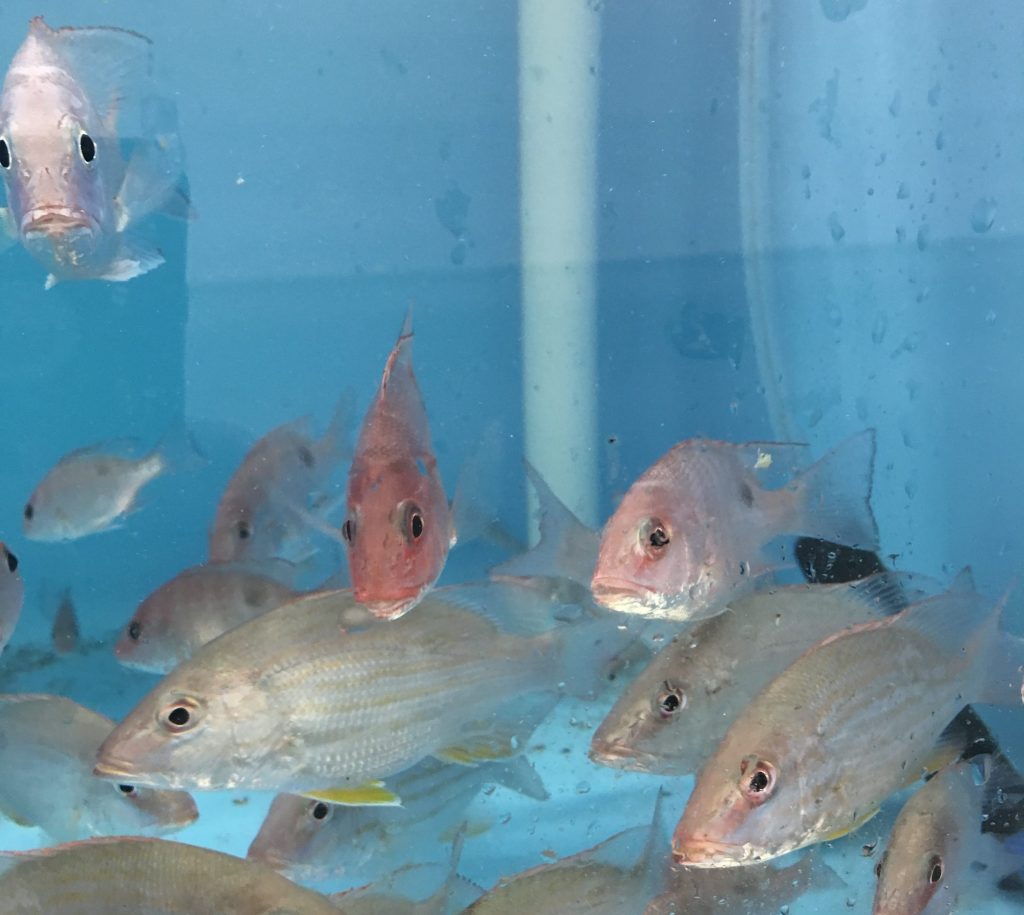
Baby Snapper – Thomas Derbes II
Eastern Oysters are a perfect representative for invertebrate batch spawning. I have gone over their life cycle in a previous article (Click Here), but I will just quickly go over their spawning habits and life history. Eastern Oysters typically spawn during the changing of the seasons, particularly from Spring to Summer and Summer to Fall. As humans, we see these changing temperatures and weather fronts as an opportunity for a new wardrobe, but these changes are triggers for oysters to spawn. Once one oyster releases their gametes into the water all of the mature oysters in the area will start releasing their gametes. Waiting to sense for other gametes in the water is a very smart tactic. This allows for a coordinated spawn between masses of oysters and (hopefully) increases the fertilization rate of the eggs. Since oysters cannot move, batch spawning is the most beneficial way for them to reproduce. Females can release anywhere from 2 to 70 million eggs in one spawning event, with only a dozen or so becoming adults. Since they are batch spawners, the larvae are left unprotected by the parents and suspended in the water column for the first few weeks, leaving them susceptible to predation by filter feeders and bad water quality. Once the larvae have reached the pediveliger stage, they will settle out and “walk” along the bottom of the estuary until they find a suitable place to call home, usually another oyster or hard substrate. After 1-3 years, the oyster will mature and begin batch spawning when conditions are ripe, and the cycle continues!
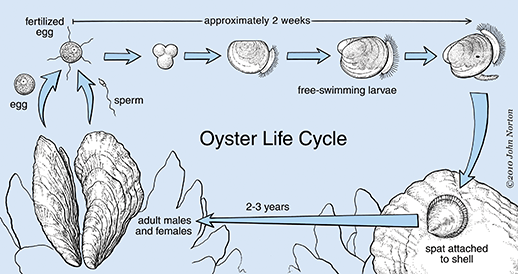
The Oyster Life Cycle – Maryland Sea Grant
Fish in the Lutjanidae (snapper) family are the perfect representative for batch spawning with fish. Snappers of all species are known to congregate and have mass spawning events typically around a full moon. The mutton snapper (Lutjanus analis) of South Florida and the Florida Keys are very well known for their ability to form massive congregations of tens of thousands of fish along the reef starting in April. Once the spawning commences, the mutton snapper will form a small subgroup of up to 20 fish in the late afternoon. This subgroup will travel to depths of up to 100ft to perform their spawning event. During this event, the female will signal to the males that she is about to release her eggs. The males will then rub up against the side of the female snapper, helping her release eggs while simultaneously releasing their milt (sperm). When the milt is released, the sperm is activated by the seawater and begins to swim. Eventually, the eggs are fertilized and an embryo is formed.

Massive Two-spot red snapper aggregation ready to spawn in Palau – R.J. Hamilton
18 – 24 hours later, the embryo is now a larval fish consisting of a yolk sac and lacking a mouth, eyes, and most organs. The yolk sac consists of amino acids and other nutrients that provide energy to the developing larvae. These larval fish have until their yolk sac runs out to develop the lacking vital organs, which usually takes between 24 – 48 hours. Only a very small percent of juvenile snapper make it to adulthood due to predation during their larval stage and predation as a juvenile. In fact, sharks and other large predators will prey on the snapper as they congregate and spawn, and filter feeders like manta rays are known to pass through an active spawning congregation to consume all the fertilized eggs and larval fish.
Well, I hope I didn’t scar anyone too badly. Batch spawning is fairly common in the marine biology world, and you can sometimes experience a spawning event without even knowing it. As for positives, this allows for many eggs to be fertilized at a time multiple times a season and for the larval fish and shellfish to be distributed through the estuary and reef via tides and waves. A major negative is the vulnerability of the juvenile and larval fish and shellfish, but the sheer number of eggs produced and fertilized helps outweigh the high potential for predation and unexplained loss of fertilized eggs and juveniles.
References:
Oyster Spawning: https://www.umces.edu/news/the-life-of-an-oyster-spawning
Mutton Snapper Species Spawning Profile: https://geo.gcoos.org/restore/species_profiles/Mutton%20Snapper/
Mutton Snapper Aquaculture Profile: https://srac.msstate.edu/pdfs/Fact%20Sheets/725%20Species%20Profile-%20Mutton%20Snapper.pdf
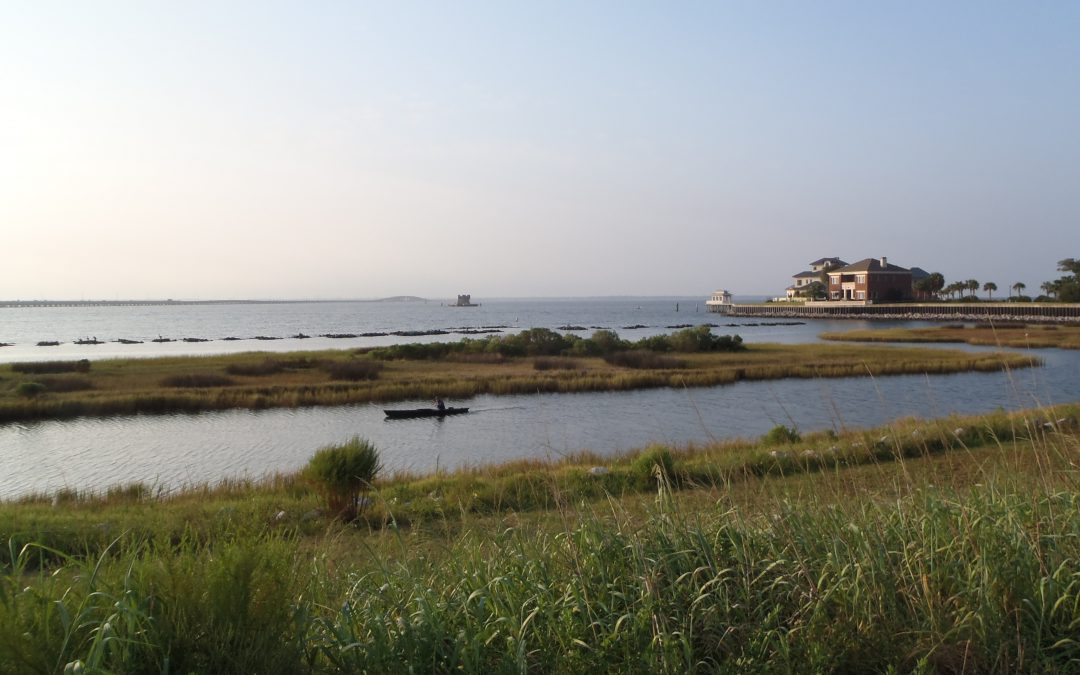
by Thomas Derbes II | Jun 21, 2024
In Part 1 of The Estuary’s Natural Filtration System article, we discussed the major contributors to natural filtration inside of the estuary. These examples included oysters, marsh plants, and seagrasses. In Part 2, we will discuss the smaller filter-feeding organisms including tunicates, barnacles, clams, and anemones.
Tunicates
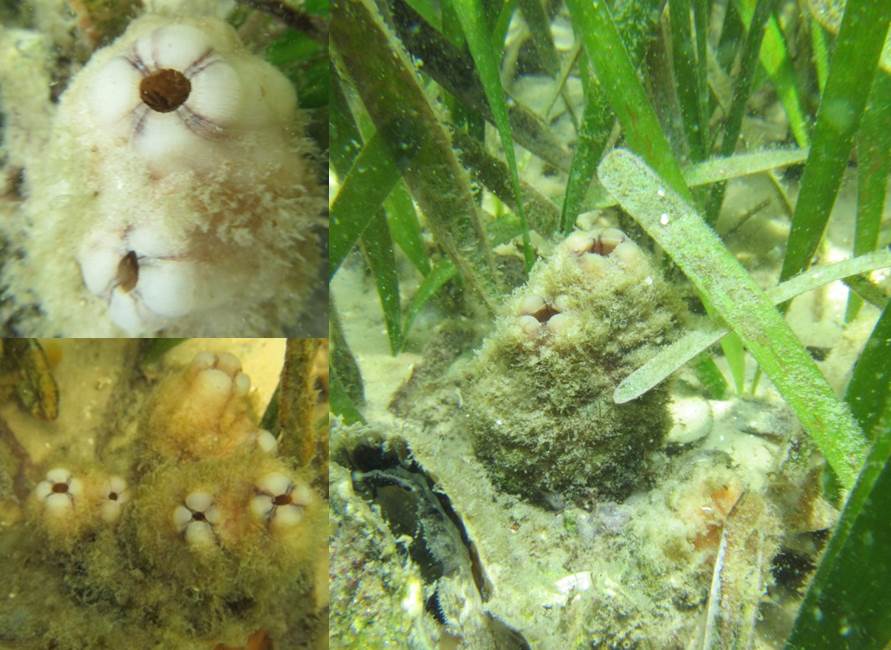
Pleated Sea Squirt – Photo Credit: Don Levitan, PH.D. FSU
Tunicates, also known as sea squirts, are very interesting marine invertebrates and can be easily confused for a sponge. There are many different types of tunicates in the estuaries and can be either solitary or colonial. You might’ve seen these at an aquarium attached to different substrates, and when removed from the water, their name sea squirt comes into play. Tunicates have a defense mechanism to shoot out the water inside their body in hopes of being released by any predator.
Tunicates are filter feeders and intake water through their inhalant siphons and expel waste and filtered water through their exhalant siphons. Tunicates can filter out phytoplankton, algae, detritus, and other suspended nutrients. The tunicate produces a mucus that catches these nutrients as it passes through, and the mucus is then conveyed to the intestine where it is digested and absorbed.
An invader to the Gulf of Mexico, the Pleated Sea Squirt (Styela plicata), hitched rides on the hulls of ships and found the Gulf of Mexico waters very favorable. You can sometimes spot these organisms on ropes that have been submerged for a long period of time in salty waters. Even though they are non-native, these sea squirts can filter, on average, 19 gallons of water per day.
Barnacles
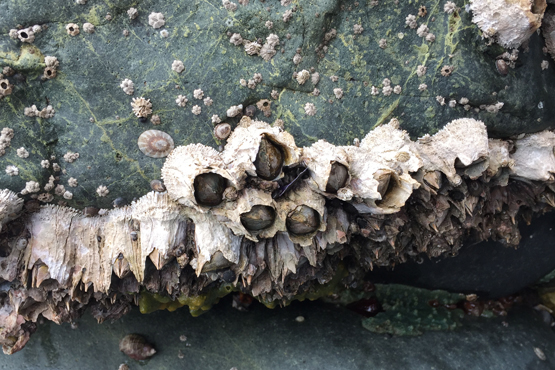
Barnacles along the seashore is a common site for many.
Photo: NOAA
One organism that seems ubiquitous worldwide is the barnacle (Genus Semibalanus and Genus Lepas). The Genus Semibalanus contains the common encrusting barnacle we are accustomed to seeing in our waterways along pilings, submerged rocks, and even other animals (turtles, whales, crabs, and oysters). The Genus Lepas contains Gooseneck Barnacles and can be seen attached to flotsam, floating organic debris, and other hard surfaces and have a stalk that attaches them to their substrate. Interesting fact, certain gooseneck barnacle species are eaten in different parts of the world.
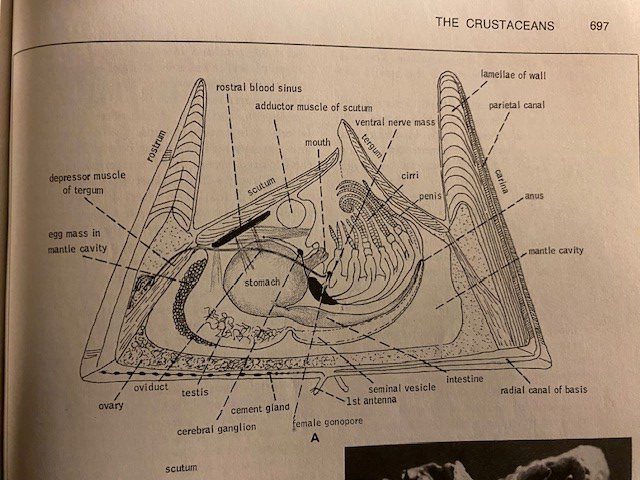
This image from a textbook shows the internal structure of a barnacle. Notice the shrimplike animal on its back with extendable appendages (cirri) for feeding.
Image: Robert Barnes Invertebrate Zoology.
Barnacles have over 2,100 species, are closely related to crabs and lobsters, and are a part of the subphylum Crustacea. At first glance, you might not think a barnacle is closely related to crabs, but when you remove the hard plates surrounding it, the body looks very similar to a crab. Barnacles also have life cycle stages that are similar to crabs; the nauplius and cyprid developmental stages. Inside of the hard plates is an organism with large feather-like appendages called cirri. When covered by water, the barnacles will extend their cirri into the water and trap microscopic particles like detritus, algae, and zooplankton. Barnacles are at the mercy of tides and currents, which makes quantifying their filtering ability difficult.
Hard Clams
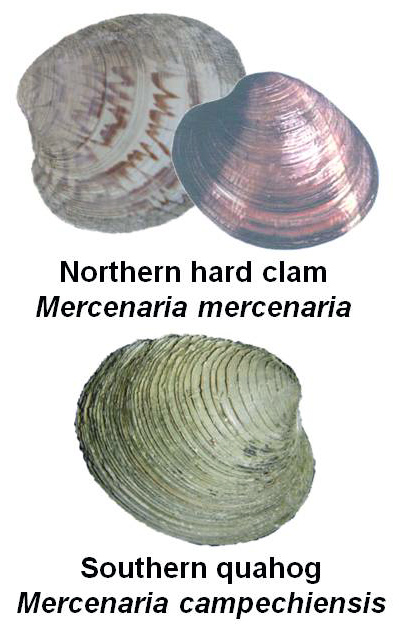
Clams of North Florida – UF/IFAS Shellfish
Even though not as abundant in the Florida Panhandle as they were in the 1970’s – 1980’s, hard clams (Mercenaria mercenaria and M. campechiensis) can still be found in the sand along the shoreline and near seagrass beds. These clams are also known as Quahogs and are in the family Veneridae, commonly known as the Venus clam family, and contain over 500 living species. Most of the clams in the family Veneridae are edible and Quahogs are the types of clams you would see in a clam chowder or clam bake.
Being the only bivalve on this list does not make it any less important than the oyster or scallop on Part 1’s list. In fact, a full-grown adult Southern Quahog clam can filter upwards of 20 gallons of water per day and have a lifespan of up to 30 years. Clams also live a much different lifestyle than their oyster and scallop cousins. Clams spend the majority of their life under the sand. Their movement under the sand helps aerate and mix the soil, which can sometimes stimulate seagrass growth.
Right outside the Florida Panhandle and in the Big Bend area, Quahog clams are commercially farmed in Cedar Key. Southern Quahog clams are also being used for restoration work in South Florida. Clams are being bred in a hatchery and their “seed” are being released into Sarasota Bay to help tackle the Red Tide (Karenia brevis) issue. According to the project’s website, they have added over 2 million clams since 2016, and the clams are filtering over 20 million gallons of seawater daily.
Anemones
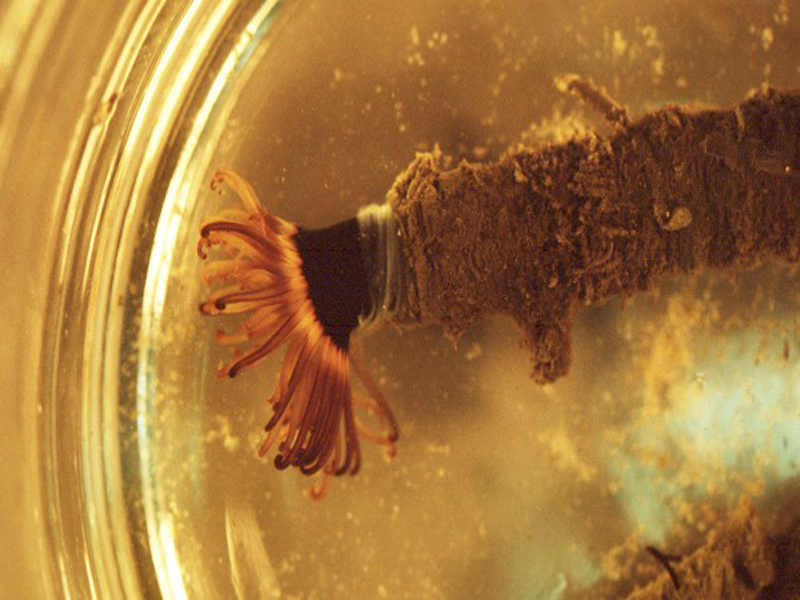
Tube-Dwelling Anemone Under Dissection Scope – UF/IFAS Shellfish
Anemones are beautiful Cnidarians resembling an upside-down, attached jellyfish, which couldn’t be closer to the truth. The phylum Cnidaria contains over 11,000 species of aquatic animals including corals, hydroids, sea anemones, and, you guessed it, jellyfish. Anemones come in many different shapes and sizes, but the common estuary anemones include the tube-dwelling anemone (Ceriantheopsis americana) and the tricolor anemone (Calliactis tricolor), also known as the hitchhiking anemone. If you have ever owned a saltwater aquarium, you might have run into the pest anemone Aiptasia (Aiptasia sp.).
Anemones filter feed with their tentacles by catching plankton, detritus, and other nutrients as the tide and current flows. The tentacles of the anemone are lined with cnidocytes that contain small amounts of poison that will stun or paralyze the prey. The cnidae are triggered to release when an organism touches the tentacles. If the anemone is successful in immobilizing the prey, the anemone will guide the prey to their mouth with the tentacles. Just like the barnacle, anemones are at the mercy of the tides and currents, and filtration rates are hard to calculate. However, if you ever see an anemone with food around, they move those tentacles to and from their mouths quickly and constantly!
In Parting
As you can see, there are many different natural filters in our estuary. Healthy, efficiently filtering estuaries are very important for the local community and the quality of the waters we love and enjoy. For more information on our watersheds and estuaries and how to protect them, visit Sea Grant’s Guide To Estuary-Friendly Living.
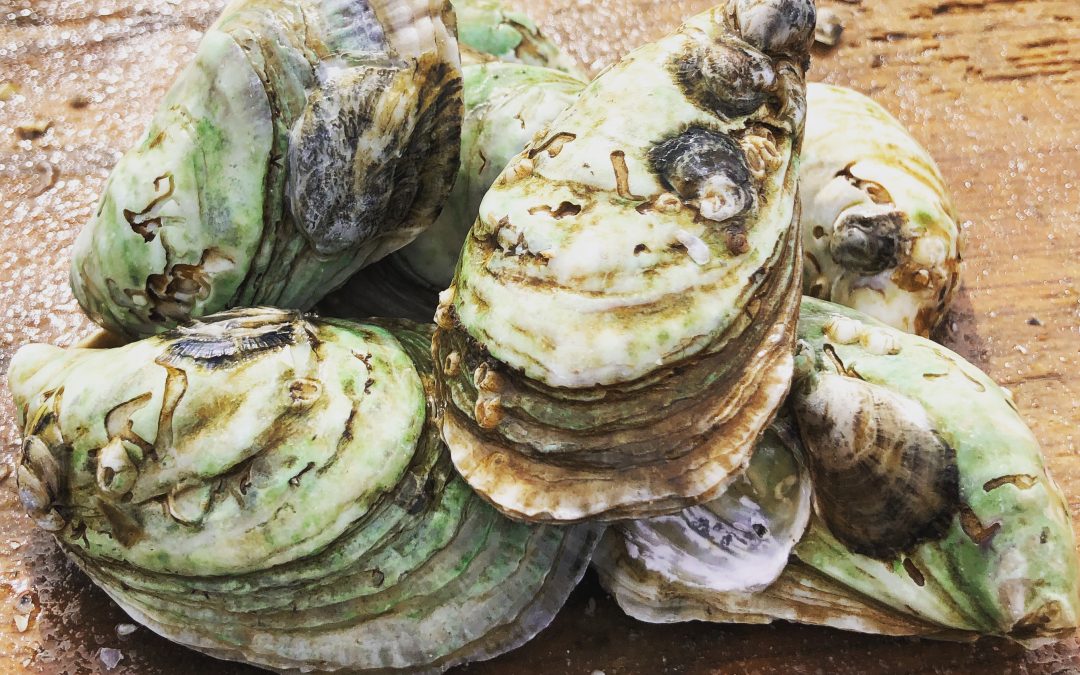
by Thomas Derbes II | May 10, 2024
The Panhandle of Florida is home to many estuaries along the coast, from the Escambia Bay System in the west to the Apalachicola Bay System in the east. These estuaries are very important and are the intersection where rivers (fed from their respective watersheds) meet the Gulf of Mexico and contain many different organisms that help filter the waters before they reach the Gulf. These organisms include oysters, marsh plants, seagrasses, scallops, tunicates, and other invertebrates. In this two-part article, we will explore marsh plants, seagrasses, oysters, and scallops.
Marsh Plants
Marsh Plants is a broad term for a family of grasses that lines the shore and contain grasses like Smooth Cordgrass (Spartina alterniflora), Saltgrass (Distichlis spicata), and Gulf Cordgrass (Spartina spartinae). These plants help trap sediments before they enter the estuary and are excellent at erosion prevention. When the water encounters the plants, it slows the flow, and this allows for sediments to collect. Marsh Plants are a great tool for shoreline restoration and are a major part of the Living Shorelines Program. The roots of the plants are also very efficient at removing nutrient pollutants like excess nitrogen and phosphorus which are major influencers in eutrophication. Marsh Plants also absorb carbon dioxide from the atmosphere and have been tabbed as “superstars of CO2 capture and storage.” (CO2 and Marsh Plants)
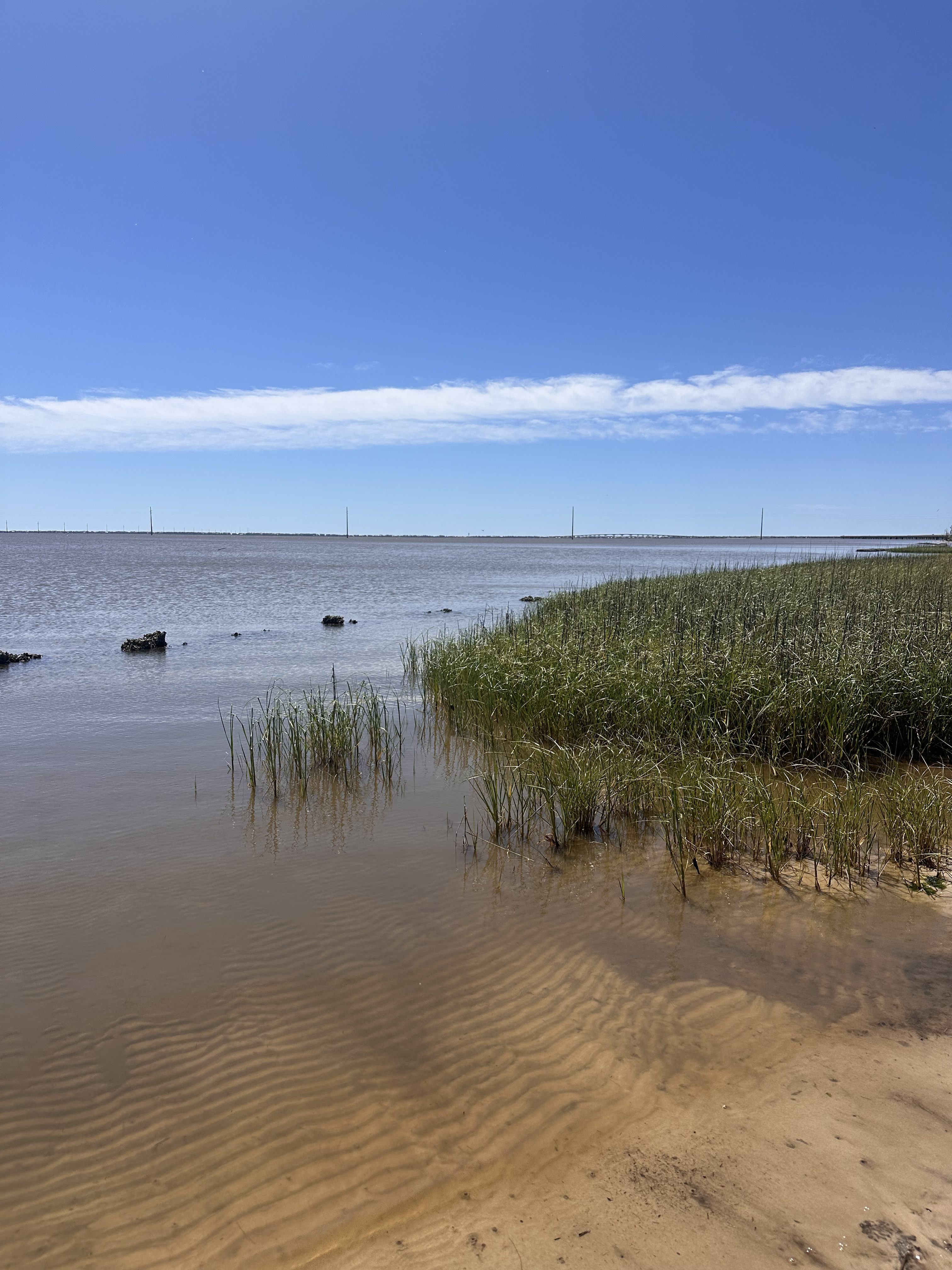
Marsh Grass and Oyster Reef in Apalachicola, Florida – Thomas Derbes II
Seagrasses
Seagrasses are different than Marsh Grasses (seagrasses are ALWAYS submerged underwater), but they offer some of the same ecological services as Marsh Grasses. The term seagrasses include Turtle Grass (Thalassia testudinum), Shoal Grass (Halodule wrightii), Widgeon Grass (Ruppia maritima), and Manatee Grass (Syringodium filiforme) to name a few. Seagrasses help maintain water clarity by trapping suspended sediments and particles with their leaves and uptake excess nutrients in their roots. Seagrasses are very efficient at capturing carbon, capturing it at rates up to 35 times faster than tropical rainforests. (Carbon Capture and Seagrasses) They also provide habitat for crustaceans, fish, and shellfish (which can filter the water too) and food for other organisms like turtles and manatees.
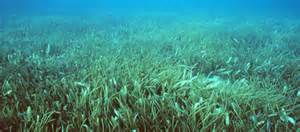
Grassbeds are also full of life, albeit small creatures.
Photo: Virginia Sea Grant
Oysters
Crassostrea virginica (or as we know them, the Eastern oyster) is a native species of oyster that is commonly found along the eastern coast of the USA, from the upper New England states all the way to the southernmost tip of Texas. Eastern oysters are prolific filter feeders and can filter between 30-50 gallons of water per day. As filter feeders, they trap nutrients like plankton and algae from the environment. In areas of high eutrophication, oysters can be very beneficial in clearing the waters by trapping and consuming the excess nutrients and sediments and depositing them on the bottom as pseudo-feces. With oyster farms popping up all over the Gulf Coast, the filtering potential of estuaries is on the rise. (Between the Hinge)

Oysters, The Powerful Filterers of the Estuary – Thomas Derbes II
Scallops
Bay Scallops (Agropecten irradians) were common along the whole Florida Gulf Coast, but their numbers have taken a recent decline and can only be found in abundance in the estuaries to the east of St. Andrews Bay in Panama City, Florida. Scallops make their home in seagrass beds and are filter feeders. While scallops do not contain the filtering potential of an oyster (scallops filter 3 gallons of water per day as an adult), they are still a key part of filtering the estuary. Just like oysters, scallops feed off of the suspended particles and plankton in the water column and deposit them as pseudo-feces on the bottom. The pseudo-feces also help provide nutrients to the seagrasses below.
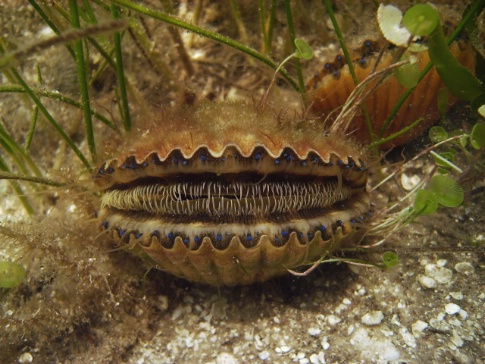
Bay Scallop.
Photo: FWC
I hope you enjoyed this first article on filterers in the estuary system. While oysters are known as the filterers of the estuary, I hope this has opened your eyes to the many different filterers that call our estuary home. Stay tuned for Part 2!
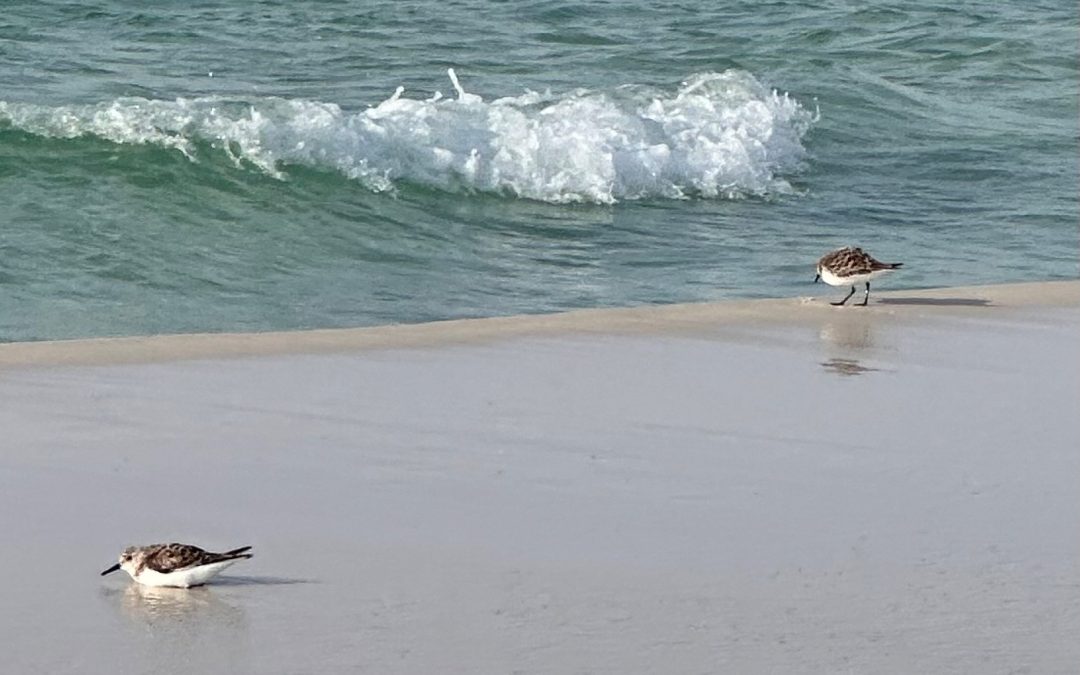
by Thomas Derbes II | May 3, 2024
I might shock a few people when I say this, but I’d rather be out in the bay somewhere rather than the beach. I just feel like I always bring a gallon of sand back on me even after washing down before getting in the car. However, there is one activity that will always get me out on the beach, and it just so happens to be the right time of the year for it. Florida Pompano (Trachinotus carolinus), aka Pompa-Yes, have started to cruise the white, sandy beaches in search of food as they migrate west to their breeding grounds. While out on a fishing trip this past weekend, the Pompano (and every other fish) eluded me, but I was blessed with an amazing array of wildlife.
When I first arrived at my spot just to the east of Portofino Towers, I was greeted with a pair of Sanderlings (Calidris alba) playing the “water is lava” game while taking breaks between waves to argue with each other and probe the sand with their beaks from marine invertebrates. When I was doing more research on sanderlings, one comment I saw was that they ran like wind-up toys, and that’s the truth! They were pretty brave too, not a single footprint of mine in the wet sand didn’t go un-probed. Sanderlings are “extremely long-distance” migratory birds that breed on the arctic tundra close to the North Pole and winter on most of the sandy beaches in the Gulf of Mexico and around the world. Non-breeding sanderlings will often stay on sandy beaches throughout the summer to save energy. They were great entertainment for the whole fishing trip.

Sanderlings in the Tide Pool – Thomas Derbes II
Brown Pelicans (Pelecanus occidentalis) were out in numbers that day. I am not the best photographer, but I was very proud to capture a Pelican mid-flight. These birds are residents of the Florida Panhandle year-round. If you’ve ever been to Pensacola, you might have bumped into one of the many Pelican Statues around the area, and they’re pretty much the unofficial mascot of the area. I am always amazed at how these seemingly big, clumsy birds can effortlessly glide over the waves and water as if they are the Blue Angels doing a low-pass. Pelicans were almost wiped out by pesticide pollution in the 1960’s, but they have made an incredible comeback.

Brown Pelican – Thomas Derbes II
While I was waiting for a Pompano to bite, I had a visit from a small Atlantic Stingray (Dasyatis sabina) that was caught in the tidepool that was running along the beach. He didn’t seem injured or sick, so I quickly grabbed a glove and released him into the gulf. Stingrays are pretty incredible creatures and can get to massive sizes, but they do contain a large, venomous spine on their tail that poses a threat to beach goers. They are not aggressive however, and a simple remedy to make sure you don’t get hit is to do the “Stingray Shuffle” by shuffling your feet while you move in the water to scare up the stingrays.
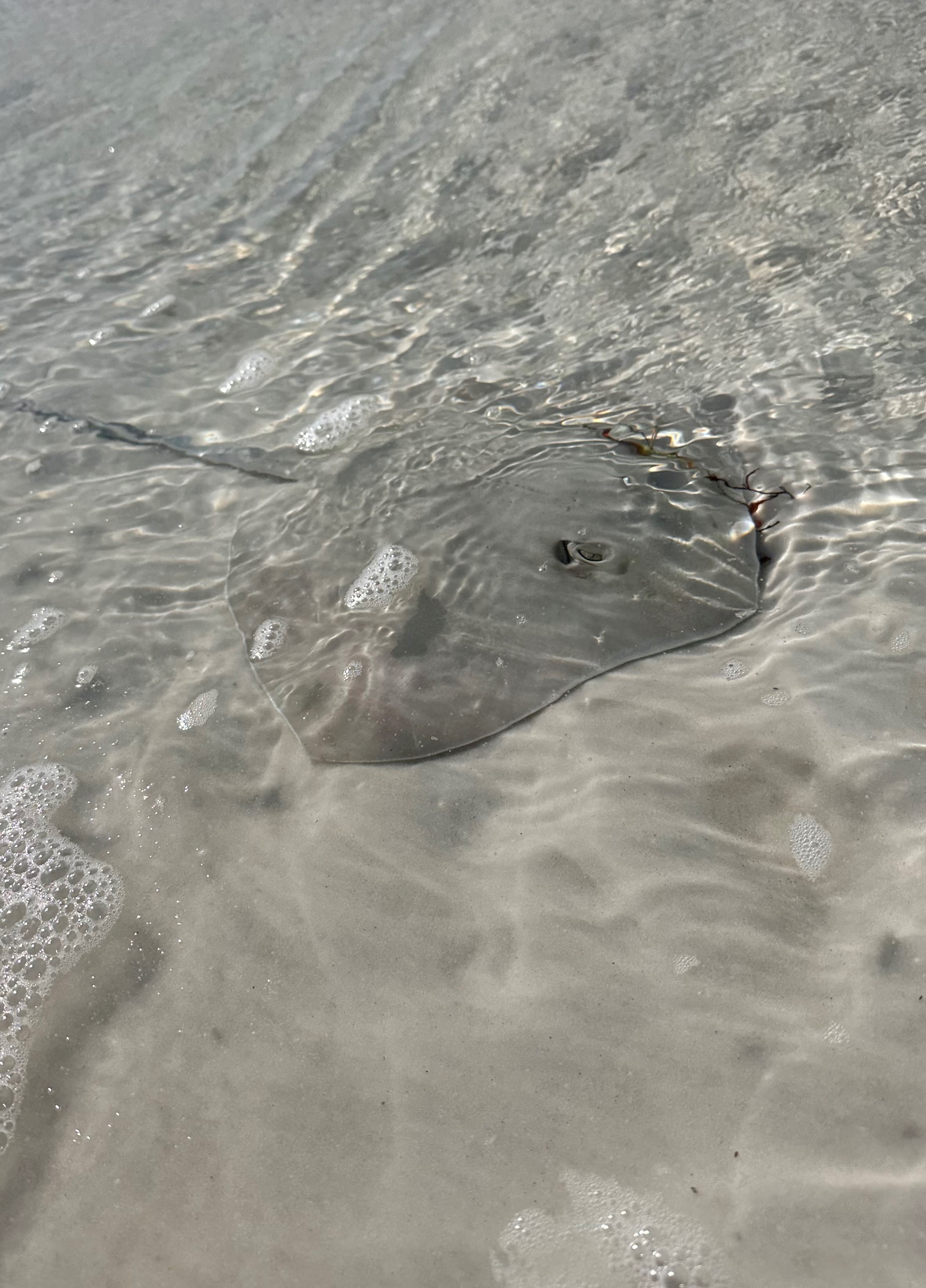
Atlantic Stingray Cruising the Tide Pool- Thomas Derbes II
As I was getting ready to pack up, I noticed a new shorebird flying in to investigate the seaweed that had washed up on shore. I had a hard time identifying this bird, but once I was able to see it in flight with its white stripe down the back, I realized it was a Ruddy Turnstone (Arenaria interpres). Turnstones get their name from their foraging behavior of turning over stones and pebbles to find food. Even though we do not have pebbles, the turnstone was looking through the seaweed for any insects or crustaceans that might be an easy meal. Turnstones are also “extremely long-distance” migratory birds breeding in the arctic tundra with non-breeding populations typically staying on sandy beaches during the summer. The turnstone made sure to stay away from me, but I was able to get a good photo of it as it ran from seaweed clump to clump.
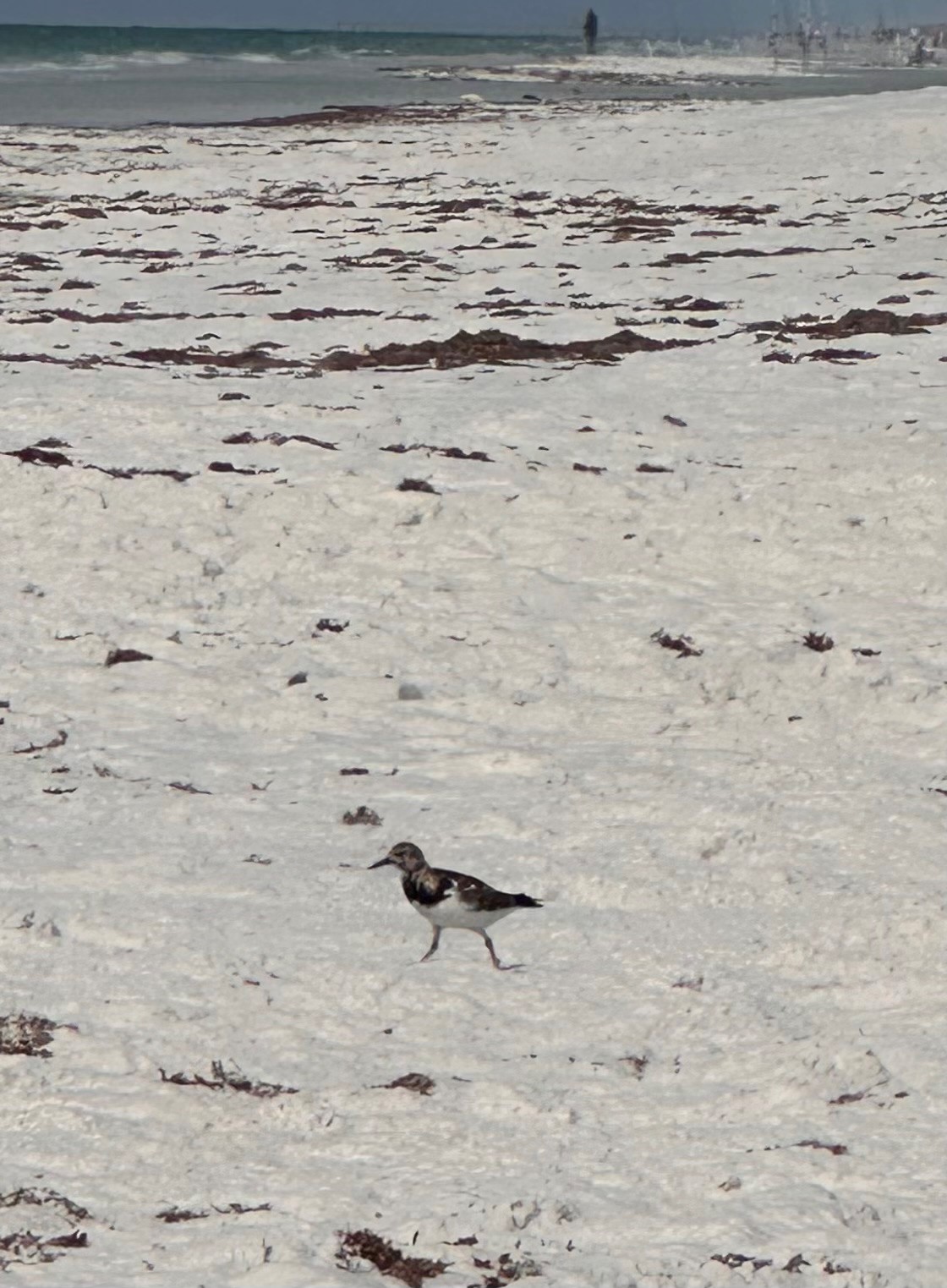
Ruddy Turnstone – Thomas Derbes II
While I didn’t catch anything to bring home for dinner, I did get to enjoy the beautiful day and playful wildlife that I wouldn’t have experienced sitting on a couch. You can turn any bad fishing day into an enjoyable day if you pay attention to the wildlife around you!























